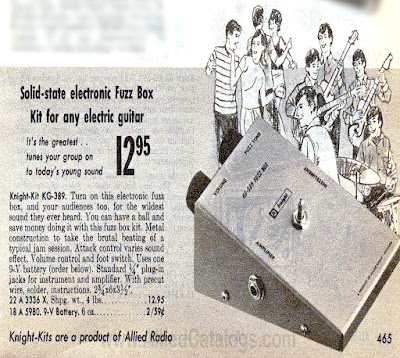

The Knight Fuzz, most interestingly, seems to be of its own design; which for a little $12 kit out of 1960’s Midwest, that’s saying a lot! Many of the fuzzes from that era were clearly Maestro rip-offs, and although the Knight is most similar in build to the Astro Amp Astrotone (1967), the two sound nothing alike. So what about it, how does this little blue wedged beastie sound?
While there are no known famous, or even obscure, recordings available of the Knight in action, there are a few decent video demos online (see this one I posted a while back). And in addition to that I also happen to have a unit right here that I can do my best to describe in ridiculous sonic detail!
Comparing it to effects you may have heard before, the Knight Fuzz Box sits somewhere between a lower gain Mosrite Fuzzrite and a more precise Jordan Boss Tone (Alhambra, V2).
It only has two controls, “Volume” and “Fuzz Tone”. The Fuzz Tone knob acts as the gain control, going from a nice round low-gain distortion all the way up to a squelchy splattery fuzz. It's also fairly sensitive, making it pretty useful at any setting. My favorite thing about the Knight Fuzz is that it retains a nice articulate bottom-end without ever getting too muddy; this was something its sonic sister the Jordan Boss Tone never got quite right. Another helpful feature is that it’s very responsive to guitar Tone and Volume adjustments, allowing for even more versatility and customization. One little trick I accidentally came across was using an old 9v battery that was on its way out; the result was a low rumbling, gated square wave fuzz perfect for bass!
So while the Knight KG-389 Fuzz Box was never meant to be more than a cool low cost project kit for aspiring musicians/electricians, over 50 years later through a combination of rarity, simplicity and individuality it stands firmly on its own among the masses of overproduced 60s wedge fuzzes. And maybe after reading this, you'll track one down for yourself and join the cool kids at the Knight club. 😎














